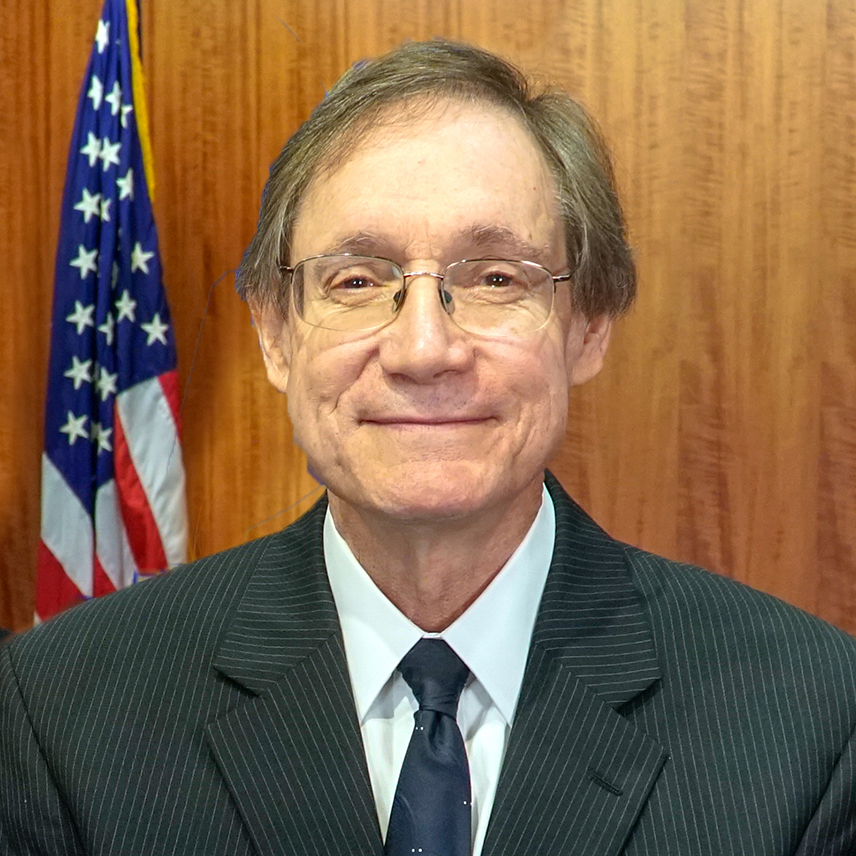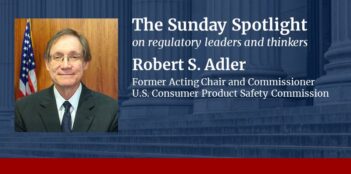
Leading U.S. consumer safety regulator reflects on his career and offers lessons for all regulatory professionals.
I have been a proud, unapologetic regulator.
I say this after completing a career that spanned almost 50 years in the world of regulation, spent variously as a regulatory agency commissioner, a congressional staff attorney overseeing several regulatory agencies, and a professor researching and teaching the subject.
Much of my experience comes from years of association with the U.S. Consumer Product Safety Commission (CPSC), which I joined in October 1973 as a Special Assistant to one of the original five commissioners.
Having worked in and studied regulation from a variety of perspectives, I hope to convey a few lessons learned and some advice for consideration. I claim no brilliant revelations, but experience can sometimes serve as a better guide than pure smarts. As Albert Einstein once said, “it is not that I am so smart. It is just that I stay with problems longer.” Having stayed with the subject so long, I hope I have gleaned some insights worth sharing.
Although the focus of this essay extends beyond the workings of one agency, I will discuss the CPSC as an example. The CPSC was established in the early 1970s as part of what has come to be known as the Consumer Decade, the period between the mid-1960s and the mid-1970s.
During the Consumer Decade, an unprecedented number of new federal regulatory agencies were established or granted new authority, including the Environmental Protection Agency (EPA), the Occupational Safety and Health Administration (OSHA), the Commodity Futures Trading Commission (CFTC), the National Highway Traffic Safety Administration (NHTSA), and, of course, the CPSC.
Many of the following 15 lessons I have learned likely extend to regulators at these agencies and others as well.
Lesson 1: Policy makers face a choice between imperfect markets and imperfect regulation. Public policy constantly seeks to balance two competing dynamics: imperfect markets versus imperfect regulation. This approach requires an ongoing reality check. Anyone who believes that markets produce optimal societal outcomes without the need for regulation lives in a dream world where dangerous products, fraudulent practices, abusive monopolies, and climate change always sort themselves out in the long run. They do not.
On the other hand, even rules drawn with the best of intentions and the greatest of skill can occasionally miss the mark or carry unintended consequences. Sadly, the CPSC discovered this years ago when its rule promoting reduced flammability for children’s sleepwear led to the use of potentially toxic flame retardants, which undercut the safety benefits from that rule.
In short, markets are flawed human institutions—despite occasional fantasies that they are divinely ordained. Regulations can be similarly flawed and fallible.
Lesson 2: Government safety regulations are usually very effective. Historic injury trends strongly suggest that health and safety agencies—many started during the Consumer Decade—have yielded net positive outcomes for consumers and the United States.
At a relatively low societal cost, regulatory agencies have dramatically reduced deaths and injuries over the past decades.
For example, when Congress began an active role in promoting automobile safety by passing the Motor Vehicle Safety Act of 1966, the U.S. population stood at 196 million. At that time, roughly 51,000 Americans died annually in automobile crashes. Fast forward to 2012, when the U.S. population had grown to 314 million—almost a 60 percent increase—yet the number of fatalities had fallen to 33,500. For each 100 million miles driven, this translates to a decline in the fatality rate from 5.5 percent to 1.1 percent—a dramatic drop by any measure.
Similarly, in its almost 50 years of operation, the CPSC has seen substantial declines in death and injury in the face of a growing population: 43 percent reduction in residential fires, 80 percent reduction in crib deaths, 88 percent decline in baby walker injuries, 80 percent reduction in child poisonings, 35 percent decline in bicycle injury rates, 55 percent decline in injuries from in-ground swimming pools, and the virtual elimination of child suffocations in refrigerators and fatalities from garage doors. I feel confident that similar statistics exist for other safety agencies as well.
Lesson 3: Regulation has produced a Great Safety Paradox. Paradoxically, the more successful regulators are in protecting the public, the less anyone notices. This paradox occurs because well-crafted safety rules do not raise prices or interfere with products’ utility. In such cases, no one notices the improvement in safety.
Most parents do not realize that the cribs they place their infants in no longer permit them to slip between the slats and strangle. Nor do they understand how much safer and less lead-laden their children’s toys are. Similarly, most consumers will never recognize that their children no longer face being crushed by a garage door that unexpectedly closes on them or that infants do not suffocate in refrigerators because the doors can now be easily opened from within.
Numerous government safety rules operate in a similar fashion, with life-saving benefits but little public recognition. This point is not a complaint, but a reminder that safety agencies play a significant—albeit often unrecognized—role in protecting the public.
In fact, most agency staff feel completely rewarded with the knowledge that they have saved the lives of thousands of consumers whom they will never meet. Or, to paraphrase an oft-quoted metaphor, the true meaning of life is to plant trees, under whose shade you do not expect to sit.
Lesson 4: Onerous rulemaking procedures are a stealthy way to undermine regulation. Students of administrative law invariably learn about the Administrative Procedure Act (APA), which governs most regulatory agencies. Section 553 of the APA—often referred to as informal rulemaking or notice-and-comment procedures—sets the requirements for writing safety and other standards.
Stated simply, agencies must publish a notice in the Federal Register, provide an opportunity for public comment, and issue a statement explaining the basis and purpose of the rule before adopting it. Should an agency fail to consider the comments filed properly or enact a rule without a reasonable basis for doing so, the courts have the authority to overturn the rule. This procedure has controlled agency rulemaking since 1946 and has served both to protect the public and provide due process to all interests affected by rulemaking.
Alas, many industry stakeholders have discovered that an extremely effective, stealthy way to undermine the rulemaking process without changing the substance or authority of agencies is to encumber them with procedures of breathtaking complexity. The stated rationale is the need for greater “due process” for industry, but the net effect is to render the pace of rulemaking akin to a herd of turtles stampeding through a vat of peanut butter.
CPSC serves as a prime example. The U.S. Congress imposed an onerous set of extra procedures on the agency in 1981. The results have been ominous and depressing. By my count, the CPSC enacted roughly 24 safety rules between its inception in 1973 and 1981, or about three standards per year. In the roughly 40 years since the new procedures were imposed on the agency, the agency has eked out only 10 rules total under these procedures, or roughly one safety standard every four years. And, I challenge anyone to demonstrate that the procedures have improved the quality of CPSC rules.
Mindful of these onerous procedures and concerned about protecting young children, Congress in 2008 returned the CPSC to the original 553 rulemaking procedures in the APA for durable infant products. Under these streamlined procedures, the CPSC has enacted 25 safety standards, or more than two per year. Unfortunately, Congress limited its reform just to a narrow segment of the agency’s jurisdiction.
In other words, providing substantive authority to an agency is only half the journey to effective regulation. Appropriate procedures matter just as much, if not more.
Lesson 5: Blaming victims is a misguided and hazardous approach. Rarely a month went by when I was at CPSC when I did not hear the taunt, “you cannot protect stupid.” Well, yes and no. Consumers may fail to follow manufacturers’ instructions or act foolishly when they use consumer products. And at some point, where consumer misbehavior is extremely reckless or completely unforeseeable, the government’s obligation to act as a protector necessarily becomes limited.
On the other hand, blaming consumers for utterly human and completely predictable behavior is too often the response of critics of safety regulation. This mindset is misguided and dangerous. Few, if any, consumers pay perfect attention or take unstinting care when using products—nor should they be held to such unattainable standards. So, failing to protect the public against the harm arising from predictable behavior unfairly places lives at risk.
For example, metal-tipped lawn darts were play products intended to be lofted to distant targets. Tragically, their needle noses could penetrate the skulls of players and bystanders and did so with an accumulating injury and fatality rate. Although long aware of the hazard, manufacturers relied on warnings and blamed “careless” consumers as their main defense against responsibility for these horrific accidents.
Unfortunately, no warnings or other safety precautions could protect against errant throws or prevent children from unexpectedly dashing into danger. The CPSC banned these products in 1988. Blaming consumers for the unreasonable risk of a badly designed product served only to delay proper safety measures.
On this point, the law is clear: consumers’ “misuse” of a product may serve to defeat or diminish the recovery in a product liability lawsuit, but rarely does it provide a basis for invalidating a product safety rule.
Product safety operates under different assumptions from product liability. Product liability affixes blame. Product safety fixes products. Product safety regulators look to whether an item can be made safe at minimal cost and inconvenience, regardless of a consumer’s use or misuse of it.
Lesson 6: Cost-benefit analysis is often controversial, but sometimes useful. When I began at the CPSC almost 50 years ago, the concept of cost-benefit analysis was fairly new and extremely controversial. Consumer advocates raged about the inhumanity of placing a dollar value on human lives. They pointed to the infamous analysis by Ford Motor Company recommending that the firm pay damages for burn injuries and deaths rather than spend $11 per car to correct the serious design flaw of the Pinto model.
That said, as cost-benefit analysis has evolved over time to be less rigid, and more expansive to include non-quantifiable items such as equity, dignity, and justice, these analyses have become more acceptable and widespread.
Nevertheless, I still have mixed feelings. I find cost-benefit analyses to be most useful when an agency is deciding between alternative approaches and trying to find which is the more beneficial. I find them to be much less helpful in deciding “go or no go” decisions such as whether to promulgate a safety rule at all. In those cases, the better approach is to examine all quantifiable and non-quantifiable concerns and then make a holistic decision.
For example, on occasion the CPSC has proceeded with rules and recalls that address hazards to young children even when a strictly by-the-numbers approach might lead the agency to forgo regulatory action. The reason is that children are highly vulnerable, involuntary risk takers. They deserve extra protection even when a rigidly mathematical economic analysis might point to “no action.”
I would add another caveat to the use of cost-benefit analysis. Too often, the analysis only focuses on the short-term costs of safety rules—which are often high—and ignores the likelihood that costs will drop as industry moves to improved production and the economies of scale kick in.
Lesson 7: Safety regulation reallocates costs; it does not add them. A closely related concern to the issue of cost-benefit analysis is the notion that regulation inevitably imposes massive new costs on society. The CPSC and its sister safety agencies often face calls to cut back their costly “job-killing” regulations that purportedly stall the U.S. economy. And the way to do this, they are told, is to subject everything that safety agencies do to elaborate cost-benefit analyses.
I dispute the premise. Critics ignore a vital point: health and safety agencies rarely impose new costs on society when they issue safety regulations. What they do is reallocate who pays the costs.
When health and safety agencies write a safety rule, they do so to eliminate or reduce deaths and injuries that consumers suffer in product-related accidents. The CPSC estimates that roughly 31,000 people die and 34 million people suffer product-related injuries every year.
These deaths and injuries impose significant costs on the economy—roughly one trillion dollars annually.
They do so first as medical costs and lost wages, then as higher premiums for health insurance—or higher taxes to pay for the uninsured. Moreover, product-related tragedies almost always result in a loss of economic productivity of the victims, not to mention the pain and suffering they experience.
Accordingly, the argument that regulations necessarily impose new costs on society is not persuasive. The costs in the form of deaths and injuries are already there, and often they impose as much of a drag on the economy as any safety rule. Furthermore, manufacturers should not externalize costs on innocent consumers that should be internalized as part of making safe products.
So, the real issue is who should bear the cost of making safer products. I believe that it should be manufacturers, not the maimed or killed consumers.
Lesson 8: Recall rates are rarely high. Anyone looking for a sure-fire criticism to level against a safety agency can point to the discouragingly low number of products returned for refunds or brought in for repairs when a safety alert is sent to the public.
Recall rates typically fail to produce a broad response from consumers regardless of the efforts of the safety agencies. To explain consumers’ sluggish response, regulators often point to preoccupied or distracted consumers.
Notwithstanding the predictably low recall rate at safety agencies, most regulatory officials pledge to investigate and fix the disappointing recall situation at their agencies to little or no avail.
Given this history of recalls, one might despair that recall rates can never be substantially improved. That said, I see one promising new approach for improving recalls: technology. In this digital age, companies’ knowledge of who their customers are and how to contact them has greatly expanded.
In fact, a firm’s ability to disable dangerous products remotely, such as by disconnecting cell phones and other appliances, may well lead to instances in which consumers who resist recall alerts may find their products inoperative until returned or repaired. Of course, such draconian steps should be reserved only for the most hazardous product defects, but it is still a positive development for product safety.
Lesson 9: Safety education campaigns are often ineffective. Critics of safety regulators have acknowledged that the public deserves hazard warnings but have insisted that consumers be free to decide the level of risk they are willing to assume. Over the years, this philosophy has led to thousands of public education campaigns designed to alert consumers to safety hazards and to persuade them to adopt safer behaviors.
I support thoughtful education campaigns that can be shown to be effective or that are useful in cases where no realistic regulatory alternatives exist. The sad truth, however, is that study after study has confirmed that education campaigns do not work very well in reducing injuries and death.
As former CPSC Commissioner R. David Pittle once said, “it is far easier to redesign products than it is to redesign consumers.” Regulators have undertaken education campaigns intending to produce substantial changes in consumer behavior with limited success.
Unfortunately, studies show that even when consumers are persuaded that safer behavior is beneficial, they will not necessarily change their behavior, especially if safer behavior requires significant changes in their daily lives. Moreover, such campaigns typically need regeneration at considerable expense to stay effective over time, which poses a major challenge for policymakers.
In the early 1980s, for example, NHTSA undertook a massive multiyear national campaign to encourage consumers to wear seatbelts. After spending millions of dollars on the campaign, the agency revealed that the rate of seatbelt use rose only from about 11 percent to 14 percent—a disappointing result however one looks at it. The seatbelt usage rate did not significantly increase until the U.S. Department of Transportation pressured the states to enact mandatory seatbelt laws.
In short, to be effective, education campaigns typically require substantial expenditures and long implementation periods and, even then, they too often produce only modest results.
Lesson 10: Lobbyists are a necessary fixture. Those who develop public policy should always expect to have lobbyists appear before them seeking to influence their decision-making. In fact, as time passes, one should not be surprised that many lobbyists turn out to be former colleagues and friends from the government. Although this is not always detrimental to the public interest, sometimes it is.
Where lobbyists can prove useful is in identifying the issues that concern their members and providing insights into their positions. Moreover, lobbyists typically have access to information about their clients that might not otherwise be available to regulators, such as who decision-makers are and how much power they carry within organizations. Furthermore, lobbyists can often help persuade reluctant clients to cooperate with the CPSC when they might otherwise distrust the agency.
All interactions that I have had with lobbyists have rested upon one fixed foundation. If I ever have reason to doubt the words or candor of a lobbyist, that person would become an instant persona non grata to me—never to be forgiven.
Lesson 11: Federal employees are neither incompetent nor lazy. As professor David E. Lewis of Vanderbilt University argued in a recent article, it is a myth that the federal bureaucracy is a bloated, unresponsive, and incompetent group. On the contrary, surveys of both Democratic and Republican federal executives reveal that the bureaucracy is extremely responsive and competent.
These results certainly match my view of the staff whom I have worked with over the years. Of course, any bureaucracy—public or private—will have its share of duds, but most of the staff at agencies such as the CPSC offer great skill and a deep commitment to saving lives.
Lesson 12: Corruption in the federal bureaucracy is rare. One of the many positive features of working in the federal bureaucracy is the discovery that bribes, kickbacks, and financial corruption are rare.
At the federal level, people rarely pay or accept bribes to avoid the rules. Of course, firms able to afford high-powered attorneys and lobbyists still have huge advantages in resolving issues that concern them. That said, I believe federal agencies generally operate openly and honestly. This fact is underappreciated.
Lesson 13: Kindness and courtesy play a vital role in leadership. I have noticed that highly-placed political appointees too often show disdain or impatience with subordinates, which undermines their effectiveness as decision-makers. Unfortunately, they act as though humility is a great quality for everyone other than themselves. I am particularly offended when such appointees bully and abuse subordinates.
Throughout my career, I have observed that truly effective leaders are those who balance kindness and courtesy with accountability.
Lesson 14: Blunt feedback from staff and stakeholders should be encouraged. I believe that one of the most vital approaches that a leader can take is to encourage robust, unvarnished feedback from staff and stakeholders. Most senior officials mouth this principle, but few practice it beyond perfunctory gestures. In my mind, a strong leader needs to encourage blunt feedback and to praise it when it is given, even when the leader disagrees with it.
On that point, I have had a practice for many years of going to lunch with knowledgeable stakeholders and beginning the meal by asking, “What is the CPSC—or what am I—screwing up?”
To my delight, once I have earned their trust, these parties have shared experiences of disappointing responses to their legitimate concerns by me and by staff, which has enabled me to provide feedback to staff and to encourage improvements in our processes, including my own.
Lesson 15: Getting close to stakeholders is important but must be done carefully. As a member of the board of directors of Consumer Reports for 20 years, I had a relatively easy time working with the various consumer groups dedicated to safety issues that came before CPSC.
What presented more of a challenge was getting to know and be trusted by other stakeholders. To do that, I made myself available to any group that wished to lobby me or complain about the agency, and I shared many lunches with industry lobbyists and lawyers––of course, always insisting that I pay my share of the tab.
I recognize that being co-opted is a serious concern for any regulator. I dealt with it by deciding at the beginning of my term that I would never work for, lobby on behalf of, consult with, or advise any of the stakeholders that have interests before the agency. I shared that commitment with the world at large.
In short, I might make bad decisions, but they would not be the result of currying favor with an outside interest for any future benefit.
* * *
Being a regulator offers the opportunity to leave a meaningful legacy. I have learned over the years that the work of regulators is hard, endless, far from divinely ordained, and anything but sexy. Ultimately, however, the meaningful impact makes the work worthwhile.
Years ago, I read an interview with a retiring partner at a major law firm who was asked what he considered his greatest professional achievement. His response was illuminating. For many years, he thwarted the efforts of the U.S. Food and Drug Administration to remove a highly profitable, but essentially useless, over-the-counter drug from the market.
One might admire the lawyer’s technical skill, but I find nothing redeeming about his career. By a wide margin, I prefer a legacy that represents my attempt to leave the world a little better than when I first entered it.




